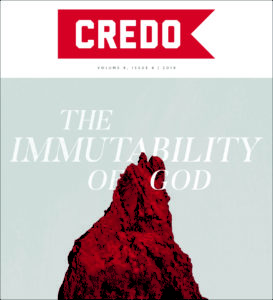You’ve probably never heard of E.A. Litton  (1813-1897). Confession: neither had I before reading this book. Litton was a 19thcentury Anglican theologian, academic, and rector. From what I can tell, he seems to have been largely forgotten in Anglican circles and never discovered in Baptist ones.
(1813-1897). Confession: neither had I before reading this book. Litton was a 19thcentury Anglican theologian, academic, and rector. From what I can tell, he seems to have been largely forgotten in Anglican circles and never discovered in Baptist ones.
Apparently, Lexham Press regards Litton’s obscurity as undeserved, because they’ve recently brought his Introduction to Dogmatic Theology (Lexham Press) back into print. Having read it, I can see why.
Purpose and Contents
Pastors wrestle with a lot of theological questions as they preach and study. If Litton’s book feels like it was made to answer those questions, it’s because it actually was. He had noticed that candidates for the Anglican clergy had no solid English-language intro to dogmatic (aka systematic) theology (vii), so he wrote this book to fill the void.
So at one level, Litton’s Dogmatics is written by an Anglican clergyman for Anglican clergymen. Each major section begins with a quote from the Thirty Nine Articles, with the book serving as a kind of commentary on them. But that doesn’t mean that no Baptists or Presbyterians need apply. Because Litton also argues up-front that rather than being a middle way between Rome, Geneva, and Wittenberg, the Church of England is a thoroughly Protestant church situated in the Reformed family (vii-viii). As such, the book can serve as a healthy reminder of how much Protestants hold in common.
Structurally Litton arranges his book around typical dogmatic theology topics, which can be summarized as follows:
1. The Rule of Faith—in which he treats sacred Scripture and its major facets (inspiration, canon, relation to tradition, etc.)
2. Christian theism—in which he deals with theology proper, including classical proofs for God’s existence, the attributes and works of God, and, of course, the Holy Trinity.
3. Man before and after the Fall—in which he covers various aspects of the doctrine of man and sin, including the image of God, dichotomy vs. trichotomy, original sin, the freedom and bondage of the will, etc.
4. The Person and Work of Christ—which expounds the major events of Christ’s life summarized in the Apostles’ Creed along with his three-fold office as prophet, priest, and king.
If this structure feels incomplete, it’s because this Lexham edition is the complete first published edition. Litton went on to add much more in later editions, including sections on soteriology, ecclesiology, and eschatology.
Enduring Relevance
Some may wonder whether a forgotten book published 1882 can still be helpful. But reading Litton’s Dogmatics is a reminder that books dealing with weighty theological questions will always be relevant. Let me discuss a couple of topics on which contemporary pastors and Christians will find Litton useful.
Trinitarian Relations
Many will recall the online debate that took place during the summer of 2016 about the Holy Trinity. The debate focused particularly on whether the Son was eternally submissive to the Father. Many of us who followed it had teachers on both sides, and we quickly realized that we knew even less about the Trinity than we had thought.
Those reading Litton against that background will find him representative of classical Trinitarian dogma. While their external works are undivided, the persons are eternally distinguished ad intra by their personal properties of paternity, filiation, and procession (141-142). The Father alone begets the Son, the Son alone is begotten from the Father, and the Spirit alone proceeds from the Father and Son. The Father alone begets the Son, the Son alone is begotten from the Father, and the Spirit alone proceeds from the Father and Son. Click To Tweet
This raises the seemingly perennial question, “Does not this introduce something like subordination among the three persons…?” (144-145). Litton responds that the persons differ neither in time (each is eternal) nor in essence (each is God), but in their “order of subsistence, according to which the Father is the first, the Son the second, and the Holy Ghost the third” (145). Referring to the Son’s eternal begottenness, Litton explains,
If we remove the element of priority of time…and conceive of an eternal generation, we arrive at the Catholic doctrine, that while a certain inequality must be admitted, the three persons are, as regards their deity, co-equal. So that the Son as God is not inferior to the Father as God, but the [Son] as a Person of the Holy Trinity stands to the [Father]…in the relation of begotten to begetting. Nor should it be forgotten that when we say the Son has his subsistence in the Father, we cannot indeed affirm the direct converse…
Thus, he affirms “a certain inequality,” but he describes it in terms of eternal relations of origin, not eternal relations of authority and submission.
Litton won’t likely settle this issue for anyone. But he does constitute a good example of pro-Nicene Trinitarianism far removed from the heat of the current debate, and is one worth grappling.[5]
Theological Method
The online Trinity-debate was also deeply intertwined with theological method. Many realized that a strictly biblicist method can have far-reaching effects, and have sought to balance the biblicism of their mentors with something closer to a Reformational sola scriptura.
Indeed, for a while now there has been a movement afoot for a retrieval of older Protestant wisdom—a wisdom that wholeheartedly affirmed sola scriptura while also embracing a high view of the classical creeds, a wide reading in the church fathers, a critical engagement with the medieval scholastics, and even an appreciation of Aristotle.
Those friendly to such retrieval should find Litton’s Dogmatics a welcome example to learn from. (Indeed, I suspect this growing interest in older Protestant dogmatics probably accounts for Lexham’s willingness to republish it.)
For example, Litton gives great deference to the Church’s historical creeds, noting that “it is more probable that [the individual Christian] should be mistaken than that the whole Church should have gone wrong” (20). At the same time, he attributes God-breathed infallibility to Scripture alone, saying “The voice of God in his written Word must control and correct the voice of God in the Church” (55).
Alongside Scripture and the Creeds, Litton also gives due deference to reason and experience as subordinate authorities. God’s existence and man’s propensity toward sin are truths which “we are led [to] on grounds of reason,” and which Scripture confirms (202, 68-72). And unregenerate man’s ability to cultivate “civic righteousness” is so obvious from experience that to interpret Scripture’s teaching on depravity so as to deny it would seem “inconsistent with the facts of history and the common judgment of mankind” (228).
All this simply to say that sola scriptura is not nuda scriptura. Scripture assumes a great deal of natural knowledge derived from reason and experience, and it shouldn’t be read in a kind of knee-jerk antithesis to other sources of knowledge. In this vein, Litton is often quite good at explaining a principle rationally and then showing how Scripture illustrates it, rather than simply deducing it from Scripture (70, 95, 98).
Welcome Back, Litton
Litton isn’t perfect. He nods towards inclusivism (322), and regards the imprecatory Psalms as an inspired record of human infirmity (34). But overall he’s solid example of rigorous, warm, Augustinian, Anglican Protestantism. His breadth of learning will instruct you, and (if you’re like me) his copious use of untranslated Latin will humble you. May Dogmatics find a wide readership, and may God use it to reform and revive the faith of the holy catholic church.


